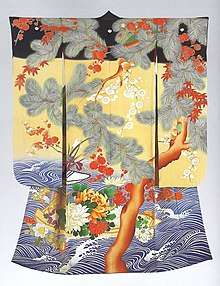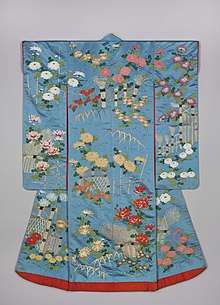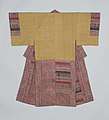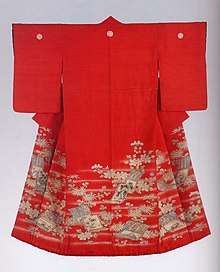Khalili Collection of Kimono
The Khalili Collection of Kimono is a private collection of Japanese kimono assembled by the British-Iranian scholar, collector and philanthropist Nasser D. Khalili, containing more than 450 items.[1] It is one of eight collections assembled, published and exhibited by Khalili, each of which is considered among the most important in its field.[2] The collection includes formal, semi-formal and informal kimono made for women, men and children.[3] It illustrates the evolution of the garments' cut, construction, materials and also the variety of motifs, patterns and decorations used from the 17th to the 20th century.[3] The kimono are not on permanent public display, but some from the collection are lent or donated to cultural institutions.[4] These have included the Kremlin Museums in Moscow[5] and the Victoria and Albert Museum in London.[6][7]
| Khalili Collection of Kimono | |
|---|---|
 Kimono for a young woman (furisode), Japan, 1912–1926 | |
| Curators | Nasser D. Khalili (founder) Dror Elkvity (curator and chief co-ordinator) Anna Jackson (honorary curator)[1] |
| Size (no. of items) | 450[1] |
| Website | www |
The collection includes kimono from the Edo period, the Meiji era, the Taishō period and the Shōwa period,[3][1] covering a period of around 300 years.[4][1] Khalili describes kimono as "one of the wonders of the world"[4] which "illustrates the history of Japan".[8] He started the collection as part of a decision "to fill the voids": to collect and catalogue types of cultural work that were not already being actively collected.[4] Another of his eight collections includes 1,400 decorative art works from the Meiji era.[9]
Kimono
"Kimono" literally means "the thing worn"[10] and the term originally meant clothing in general rather than a specific type.[11] Garments similar to the modern kimono first appeared in the Momoyama era (1573–1603).[10] Kimono are made from lengths of cloth, stitched together with straight seams, draped over the shoulder and secured with an obi – a sash.[11] While Western clothing styles emphasise the body of the wearer, kimono have a distinctive T-shape which hides the shape of the wearer's body but provides, on the back, a large flat area for decoration with patterns or motifs.[12] These colours and decorations often carry complex meanings, with emotional, religious, or auspicious significance.[13] They may refer to folklore, classical literature, or popular culture, and can include visual puns.[13] The choice of fabric, colours, and decorative technique for a kimono are signs of the gender, status, and class of the wearer.[12][14][15] Kimono are well-suited to Japan's climate: lined or unlined variations can be worn in different seasons.[14] The variation and experimentation visible in the history of kimono shows that Japan had a fashion industry, with rapidly-changing popular styles, whereas this used to be thought of as a Western phenomenon.[3][16]

The different forms of kimono represented in the Khalili Collection include furisode ("swinging sleeve"; a formal kimono for young women), kosode ("short sleeve"; a unisex outer garment)[15] and uchikake (an outer kimono worn without sash).[17]
Edo period (1603–1868)
The Edo period introduced a wide variety of designs and decorative techniques, especially for kimono worn by women.[10] The main consumers of kimono were the military class – the samurai – who used lavish clothing and other material luxuries to signal their place at the top of the social order.[18] Driven by this demand, the textile industry grew and used increasingly sophisticated methods of weaving, dyeing, and embroidery.[18] Over this period, women adopted brighter colours and bolder designs, whereas women's and men's kimono had been very similar.[13] The rise of a merchant class fuelled more demand for elaborate costumes. While ordinary kimono would usually be created by women at home, luxurious silk kimono were designed and created by specialist artists who were usually men.[19]
The Khalili Collection includes some white satin examples patterned with flowers, geometric patterns or emblems such as clouds or waves. These would have been worn as formal dress by samurai women.[20] The military connection is more explicit on a bright red kimono illustrated with gunbai war fans.[20] Another kind of kimono specific to the military elite is the goshodoki or "palace court style", which would be worn in the residence of a military leader (a Shogun or daimyō). These would have landscape scenes, among which there are other motifs usually referencing classic literature. The collection has several examples of this type, often with symbolism referring to stories made popular by Noh plays.[21] Samurai men would dress with a more understated design, exemplified by items in the collection with geometrical designs concentrated around the waist.[22] The yogi, or sleeping kimono, is a thickly wadded form of wearable bedding. The Khalili Collection has some examples from samurai families: whereas yogi would normally have simple designs, these are especially elaborate and are made of silk rather than the usual cotton.[23]
Other items have rich decoration from the waist down only, and family emblems on the neck and shoulders: a style called tsuma moyō. These would be worn by women of the merchant class.[24] The kimono of merchant-class women were more subdued than those of the samurai, but still with bold colours and designs representing nature.[25] Red was a popular colour for wealthy women, partly because of its cultural association with youth and passion, and partly because the dye – derived from safflower[14] – was very expensive, so a bright red garment was an ostentatious display of wealth.[26] Indian fabrics, brought to Japan by Dutch importers, were received with enthusiasm and found many uses. The collection includes a flamboyant under-kimono for a man made by combining these finely patterned fabrics with plain-weave silk and cotton.[27] Other items show that Japanese designers started printing designs that were influenced by the Indian patterns.[28] Another example in the collection uses fabric imported from Britain or France: ownership of this exotic textile signified wealth and taste, but it was worn as an undergarment where the design would not be seen.[29]
Worn by less wealthy merchants, lower down the social scale, are kimono made of cotton or ramie and dyed with indigo, with less dense designs but still a variety of dyes, patterns and techniques.[30]
 Kimono for a woman (kosode) with a design inspired by the Eight Views of Ōmi, 1780–1820
Kimono for a woman (kosode) with a design inspired by the Eight Views of Ōmi, 1780–1820 Underkimono for a man (juban) using Indian fabrics, 1800–1850
Underkimono for a man (juban) using Indian fabrics, 1800–1850 Outer kimono for a young woman (uchikake); landscape scene with bridge, pavilions and thatched huts, 1840–1870
Outer kimono for a young woman (uchikake); landscape scene with bridge, pavilions and thatched huts, 1840–1870 Summer kimono for a woman (katabira) depicting a landscape with fishing nets, 1820–1850
Summer kimono for a woman (katabira) depicting a landscape with fishing nets, 1820–1850
Meiji era (1868–1912)
The Meiji era was a period of modernisation and industrialisation, during which Japan opened itself to the world.[31] It saw a rapid introduction of Western culture to Japan, and also of Japanese culture into Europe and America, where kimono became an object of fascination.[11] The production of kimono started to use Western technologies such as synthetic dye, and decoration was sometimes influenced by Western motifs.[32] The textile industry modernised rapidly and silk from Tokyo's factories became Japan's principal export.[33] Cheap synthetic dyes meant that bold purples and reds, previously restricted to the wealthy elite, could be owned by anyone.[34] Faster and cheaper manufacture allowed more people to afford silk kimono, and enabled designers to create new patterns.[34] The Emperor issued a proclamation promoting Western dress over the allegedly effeminate Japanese dress.[35] Fukuzawa Yukichi journeyed to Europe and the United States and the books he wrote about Western clothing and customs were influential.[36] So Western dress became popular in the public sphere: many men adopted Western dress in the workplace, although kimono were still the norm for men at home and for women.[37] In the 1890s the kimono reasserted itself, with people wearing bolder and brighter styles. A new type called the hōmongi bridged the gap between formal dress and everyday dress.[33]
The Khalili Collection has items that illustrate the trends of the Meiji era. Several have a plain, bold colour with elaborate design around the hem.[38] The technology of the time allowed for subtle colour gradients rather than abrupt changes of colour. Another trend was for outer and inner garments of the same design.[38] One trend in the Meiji era was for women's under-kimono made by combining pieces of different fabric, sometimes of radically different colours and designs. The collection has examples of these.[39] For men, the trend was for highly decorative under-kimono that would be covered by outer kimono that were plain or very simply designed. Among the Khalili examples, an undergarment depicts performers and dancers among haiku poems. Another combines postcard-like scenes of Japan's progress with a textual diary of the Meiji era.[40]
Even the clothing of infants and young children used bold colours, intricate designs, and materials common to adult fashions. The collection has many examples, including a boy's kimono and under-kimono set, decorated with cranes and pine trees, and a girl's set that combines a deep blue outer garment with a bright red undergarment.[41]
 Outer kimono for a young woman (uchikake) depicting hawks in pine trees, 1870-1900
Outer kimono for a young woman (uchikake) depicting hawks in pine trees, 1870-1900 Kimono for a woman (kosode) showing flowers on rafts, 1870-1900
Kimono for a woman (kosode) showing flowers on rafts, 1870-1900 Outer kimono for a young woman (uchikake) depicting hawks, 1880-1900
Outer kimono for a young woman (uchikake) depicting hawks, 1880-1900 Outer kimono for a woman (uchikake) with hanging scroll motifs, 1880–1890
Outer kimono for a woman (uchikake) with hanging scroll motifs, 1880–1890
Taishō and early Shōwa periods (1912–1950)
The early twentieth century brought a new mix on cultural influences, including greater nationalism and greater Western influence; especially Art Nouveau and Art Deco.[42] The imagery on kimono – particularly boys' kimono – reflected this, with depictions of skyscrapers, cars or planes to celebrate the modern world.[14] Kimono of these periods are distinguished by vibrant colours and an enormous variety of designs.[43] Mass-produced garments used printing to cheaply imitate traditional dyeing processes.[44] A type of inexpensive, durable, printed silk kimono known as meisen became very popular.[45] Urban culture of the Taishō period was marked by modanizumu (modernism) which celebrated Western art movements and fashion.[45] In many aspects of Japanese culture, there was a tension between traditional, orthodox, Japanese influences and modern, Western, subversive influences. The bold new kimono designs were a middle ground that combined aspects from both.[46] With the rise of Japanese militarism in the 1930s, male kimono designs adopted explicitly militaristic imagery, including soldiers, bombers and tanks.[44][47] These designs were not on public display but on linings and undergarments. They symbolised – or in the case of boy's clothes, were hoped to bring about – the alignment of the individual's goals with those of Japan as a whole.[48]
The Khalili Collection has items that illustrate the overlap of modern and traditional in these eras, combining traditional motifs with very bold, modern colours.[49][50] The tension between traditional motifs and abstractions during these periods is visible in the many kimono decorated with repeating patterns. These inhabit a spectrum from geometric block patterns to floral patterns, with some having floral motifs repeating within a striped or other pattern. These repeating patterns were achieved with stencil printing or by selective dyeing.[51] As well as stripes and checks, the geometrical patterns used include arabesques and swastikas. One fashion trend of the 1930s, represented in the collection, was for black kimono with abstract patterns in red, yellow, cream and white.[52]
The semi-formal, colourfully-decorated hōmongi style is represented in the collection,[53] as is a formal, black style with decoration limited to below the waist.[54] The collection also has examples of modernist kimono whose decoration celebrates modern forms of transport including ocean liners. These include military-themed kimono from World War II, depicting tanks, warships and aircraft.[55]
 Kimono for a young girl depicting drums and flowers, 1912–1926
Kimono for a young girl depicting drums and flowers, 1912–1926 Outer kimono for a woman (uchikake), 1920–1930. A wedding kimono, this depicts cranes which symbolise a long marriage.
Outer kimono for a woman (uchikake), 1920–1930. A wedding kimono, this depicts cranes which symbolise a long marriage. Kimono for a girl (furisode), 1920–1940. An example of patterns created by stencil printing
Kimono for a girl (furisode), 1920–1940. An example of patterns created by stencil printing Kimono for a Woman with a skyscraper motif, 1930–1940
Kimono for a Woman with a skyscraper motif, 1930–1940
Publications
The collection has been the subject of two books. Kimono: The Art and Evolution of Japanese Fashion, edited by Anna Jackson, was first published in English in 2015 and also has French and Italian translations.[9] It describes, with photographs, 220 items from the collection and includes essays explaining how the evolution of the kimono reflected political, social and cultural changes in Japan.[3] Jackson is the Keeper of the Asian Department at the Victoria and Albert Museum.[1] Images of Culture: Japanese Kimono 1915–1950 by Jacqui Atkins is scheduled for publication in 2021.[56]
Exhibitions
Items from the collection were included in the 2017 Treasures of Imperial Japan exhibition at the Kremlin Museums[5] and in Kimono: Kyoto to Catwalk at London's Victoria and Albert Museum in 2020:[6] an event that was curtailed by the coronavirus pandemic.[57]
References
- "Japanese Kimono". Khalili Collections. Retrieved 2020-02-14.
- "The Khalili Collections major contributor to "Longing for Mecca" exhibition at the Tropenmuseum in Amsterdam". www.unesco.org. United Nations Educational, Scientific and Cultural Organization. 16 April 2019. Retrieved 2020-02-14.
- Kramer, Elizabeth (2017-07-03). "Book Reviews: 'Kimono: The Art and Evolution of Japanese Fashion'". Textile History. 48 (2): 285–286. doi:10.1080/00404969.2017.1379761. ISSN 0040-4969.
- Gómez, Edward M. (2016-02-13). "The Kimono, Examined: A New Book and a Definitive Collection". Hyperallergic. Retrieved 2020-02-14.
- Muchnik, Andrei (2017-09-14). "The Moscow Fall Art Season Sizzles". The Moscow Times. Retrieved 2020-02-14.
- "Kimono: Kyoto to Catwalk". Victoria and Albert Museum. Retrieved 2020-02-14.
- Borrelli-Persson, Laird (29 February 2020). "Kimono: Kyoto to Catwalk at the V&A Explores the History, and Global Appeal, of Japan's National Dress". Vogue. Retrieved 2020-03-04.
- Groom, Avril (2016-10-12). "The new allure of vintage kimonos". ft.com. Retrieved 2020-02-14.
- "The Eight Collections". Khalili Foundation. Retrieved 2020-02-14.
- Iwao 2015, p. 8.
- Iwao 2015, p. 9.
- Iwao 2015, p. 10.
- Jackson, "Dress in the Edo period" 2015, p. 22.
- "Kimono". Victoria and Albert Museum. Retrieved 2020-02-20.
- Green, Cynthia (2017-12-08). "The Surprising History of the Kimono". JSTOR Daily. Retrieved 2020-02-25.
- Jackson, "Dress in the Edo period" 2015, p. 25.
- Victoria and Albert Museum (2015-11-02). "Japanese Art and Design: A Glossary". www.vam.ac.uk. Retrieved 2020-02-25.
- Jackson, "Dress in the Edo period" 2015, p. 20.
- Jackson, "Dress in the Edo period" 2015, p. 24.
- Jackson, "Dress in the Edo period" 2015, pp. 29–30.
- Jackson, "Dress in the Edo period" 2015, pp. 35–44.
- Jackson, "Dress in the Edo period" 2015, pp. 76–78.
- Jackson, "Dress in the Edo period" 2015, pp. 93–95.
- Jackson, "Dress in the Edo period" 2015, pp. 46–51.
- Jackson, "Dress in the Edo period" 2015, p. 54.
- Jackson, "Dress in the Edo period" 2015, p. 63.
- Jackson, "Dress in the Edo period" 2015, p. 80.
- Jackson, "Dress in the Edo period" 2015, pp. 80–84.
- Jackson, "Dress in the Edo period" 2015, p. 87.
- Jackson, "Dress in the Edo period" 2015, pp. 96–102.
- Guth 2015, pp. 106–107.
- Iwao 2015, p. 11.
- Jackson, "Dress in the Meiji period" 2015, p. 117.
- Jackson, "Dress in the Meiji period" 2015, p. 118.
- Jackson, "Dress in the Meiji period" 2015, p. 112.
- Jackson, "Dress in the Meiji period" 2015, p. 113.
- Guth 2015, p. 110.
- Jackson, "Dress in the Meiji period" 2015, pp. 126–134.
- Jackson, "Dress in the Meiji period" 2015, p. 137.
- Jackson, "Dress in the Meiji period" 2015, pp. 138–141.
- Jackson, "Dress in the Meiji period" 2015, pp. 142–144.
- Jackson, "Dress in the Taishō and early Shōwa periods" 2015, pp. 163–164.
- Jackson, "Dress in the Taishō and early Shōwa periods" 2015, p. 160.
- Atkins, Jacqueline M. (September 2008). "Omoshirogara Textile Design and Children's Clothing in Japan 1910–1930". Textile Society of America Symposium Proceedings. Paper 77. Retrieved 21 February 2020.
- Jackson, "Dress in the Taishō and early Shōwa periods" 2015, p. 161.
- Jackson, "Dress in the Taishō and early Shōwa periods" 2015, p. 162.
- Perkins, Sam (2016-11-16). "The Propaganda Kimonos Japan Kept Hidden From Outsiders". Atlas Obscura. Retrieved 2020-02-21.
- Jackson, "Dress in the Taishō and early Shōwa periods" 2015, p. 165.
- Jackson, "Dress in the Taishō and early Shōwa periods" 2015, pp. 166–168.
- Jackson, "Dress in the Taishō and early Shōwa periods" 2015, p. 174.
- Jackson, "Dress in the Taishō and early Shōwa periods" 2015, pp. 180–201.
- Jackson, "Dress in the Taishō and early Shōwa periods" 2015, pp. 251–252.
- Jackson, "Dress in the Taishō and early Shōwa periods" 2015, pp. 170–171.
- Jackson, "Dress in the Taishō and early Shōwa periods" 2015, p. 173.
- Jackson, "Dress in the Taishō and early Shōwa periods" 2015, pp. 304–306.
- "Khalili Collections | images of culture". Khalili Collections. Retrieved 2020-02-14.
- Victoria and Albert Museum. "Coronavirus update". www.vam.ac.uk. Retrieved 2020-04-08.
Sources
- Guth, Christine M. E. (2015). "The Meiji era: the ambiguities of modernization". In Jackson, Anna (ed.). Kimono: the art and evolution of Japanese fashion. London: Thames & Hudson. pp. 106–111. ISBN 9780500518021. OCLC 990574229.CS1 maint: ref=harv (link)
- Iwao, Nagasaki (2015). "Clad in the aesthetics of tradition: from kosode to kimono". In Jackson, Anna (ed.). Kimono: the art and evolution of Japanese fashion. London: Thames & Hudson. pp. 8–11. ISBN 9780500518021. OCLC 990574229.CS1 maint: ref=harv (link)
- Jackson, Anna (2015). "Dress in the Edo period: the evolution of fashion". In Jackson, Anna (ed.). Kimono: the art and evolution of Japanese fashion. London: Thames & Hudson. pp. 20–103. ISBN 9780500518021. OCLC 990574229.
- Jackson, Anna (2015). "Dress in the Meiji period: change and continuity". In Jackson, Anna (ed.). Kimono: the art and evolution of Japanese fashion. London: Thames & Hudson. pp. 112–151. ISBN 9780500518021. OCLC 990574229.
- Jackson, Anna (2015). "Dress in the Taishō and early Shōwa periods: traditions transformed". In Jackson, Anna (ed.). Kimono: the art and evolution of Japanese fashion. London: Thames & Hudson. pp. 160–311. ISBN 9780500518021. OCLC 990574229.
External links
| Wikimedia Commons has media related to Khalili Collection of Japanese Kimono. |